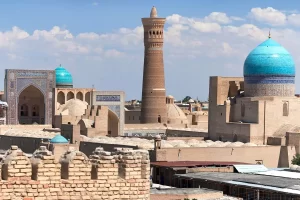Essential Information
Bukhara, one of Central Asia’s most historic cities, is a UNESCO-listed treasure trove of ancient architecture, rich Islamic heritage, and vibrant bazaars. With over 2,500 years of history, it was once a major center of the Silk Road trade route and a hub of Islamic learning. Today, Bukhara is a living museum, where visitors can explore well-preserved madrasahs, towering minarets, and traditional caravanserais.
- Location: Central Uzbekistan
- Language: Uzbek (official), Russian widely spoken, limited English.
- Currency: Uzbekistani Som (UZS) – Cash is preferred, but some hotels and restaurants accept cards.
- Best Time to Visit: Spring (April-May) and autumn (September-October) offer ideal weather.
- Visa Requirements: Many nationalities qualify for visa-free entry or an e-visa.
Interesting Facts About Bukhara
- A City Over 2,500 Years Old – Bukhara was a key Silk Road trading post and one of the greatest centers of Islamic civilization.
- Home to Over 140 Architectural Monuments – The city is an open-air museum with stunning mosques, madrasahs, and minarets.
- The Birthplace of Avicenna – The legendary Persian philosopher and scientist, known as the father of early modern medicine, was born near Bukhara.
- The Kalyan Minaret Once Saved the City – Genghis Khan was so impressed by its grandeur that he spared it while destroying the rest of Bukhara.
- Traditional Bukharan Tea Houses – Enjoying spiced green tea in Bukhara’s ancient tea houses (chaikhanas) is a must for visitors.
How to Get There
By Air
- Bukhara International Airport (BHK) offers domestic and international flights from Tashkent, Moscow, and Istanbul.
- The airport is 6 km from the city center, with taxis readily available.
With Train
- The Afrosiyob high-speed train connects Tashkent to Bukhara in under 4 hours.
- Other trains connect Bukhara to Samarkand and Khiva.
By Road
- Shared taxis and buses run between Tashkent, Samarkand, and Khiva.
- A drive from Tashkent takes around 6-7 hours.
Best Things to Do in Bukhara
1. Explore the Historic Poi Kalyan Complex
- Home to Kalyan Minaret, Kalyan Mosque, and Mir-i-Arab Madrasah.
- The 48-meter Kalyan Minaret, built in the 12th century, is one of Bukhara’s most iconic landmarks.
2. Wander Through Lyabi Hauz
- A beautiful pond surrounded by tea houses and the Nadir Divan-Begi Madrasah.
- A perfect spot to relax with Uzbek tea and local sweets.
3. Visit the Ark of Bukhara
- A massive fortress dating back over 1,500 years.
- Once the residence of Bukharan emirs, it now houses a museum of Bukhara’s history.
4. Marvel at the Chor Minor
- A unique four-towered madrasah, built in 1807, with an unusual architectural style.
- It was once the gateway to a larger religious complex.
5. Shop at the Covered Bazaars
- Explore Toki Zargaron, Toki Telpak Furushon, and Toki Sarrafon, three ancient trading domes where Silk Road merchants once sold their goods.
- Find handmade carpets, silk scarves, and traditional ceramics.
6. Visit the Bolo Hauz Mosque
- Known for its wooden pillars and stunning reflections in the nearby pond.
- It was the Friday mosque for Bukharan emirs.
Best Accommodation in Bukhara
Luxury Hotels
- Hotel Minorai-Kalon – Offers luxurious rooms with views of Kalyan Minaret.
- Liyabi Hauz Hotel – A charming boutique hotel near Lyabi Hauz.
Mid-Range Hotels
- Sasha & Son Hotel – A traditional Bukharan-style guesthouse with a historic ambiance.
- Amelia Boutique Hotel – Offers cozy rooms and excellent hospitality.
Budget Accommodation
- Rumi Hostel – A popular backpacker-friendly option.
- Bukhara Art Hotel – Combines affordability with traditional charm.
Cultural and Modern Attractions
1. Bukhara State Museum of Art & History
- Showcasing ancient artifacts, manuscripts, and Bukharan royal treasures.
2. Fayzulla Khodjaev House Museum
- A preserved 19th-century Bukharan merchant’s house with stunning interior decor.
3. Bukhara Puppet Theatre
- Experience traditional Uzbek puppet shows, a unique cultural attraction.
4. Modern Art & Handicraft Centers
- Visit Samani Park to see contemporary art exhibitions and local crafts.
Dining and Nightlife in Bukhara
Best Restaurants
- Chinar Restaurant – Serves delicious plov, kebabs, and Uzbek soups.
- Old Bukhara Restaurant – Famous for shashlik (grilled meat skewers) and fresh bread.
- Ayvan Restaurant – Offers a mix of Uzbek and Persian cuisine in a traditional setting.
Nightlife in Bukhara
- Silk Road Teahouse – A great place to enjoy local tea and traditional sweets.
- Minzifa Rooftop Café – A perfect spot for evening drinks with a view.
Day Trips from Bukhara
1. Sitorai Mokhi-Khosa (8 km)
- The summer palace of the last Emir of Bukhara, featuring a mix of Russian and Central Asian architecture.
2. Gijduvan (50 km)
- Famous for its handmade ceramics and pottery workshops.
3. Vabkent Minaret (30 km)
- A well-preserved 12th-century minaret, similar in style to the Kalyan Minaret.
Getting Around Bukhara
- Taxis – The easiest way to get around. Always negotiate fares beforehand.
- Walking – The old town is pedestrian-friendly, with most attractions within walking distance.
- Buses & Marshrutkas – Cheap but best for locals.
Practical Tips for Visiting Bukhara
- Cash is Essential – Many places do not accept credit cards.
- Dress Modestly – Especially when visiting religious sites.
- Learn Basic Uzbek or Russian Phrases – English is not widely spoken.
- Bargain in Markets – Haggling is expected at souks and bazaars.
- Avoid Tap Water – Stick to bottled or filtered water.
Conclusion
Bukhara is one of the best-preserved medieval cities in the world, offering visitors a glimpse into the past of the legendary Silk Road. Whether you’re exploring historic madrasahs, shopping in bustling bazaars, or indulging in authentic Uzbek cuisine, Bukhara promises a magical journey through history and culture.

